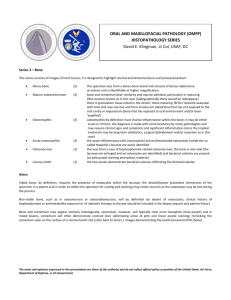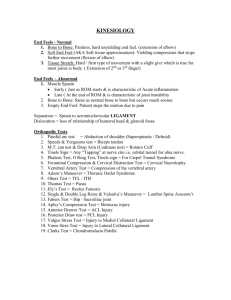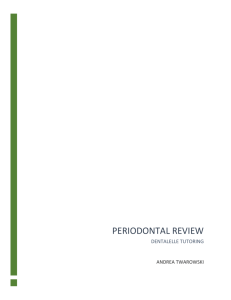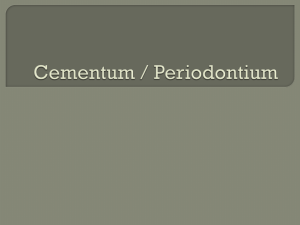The Tooth-Supporting Structures
advertisement
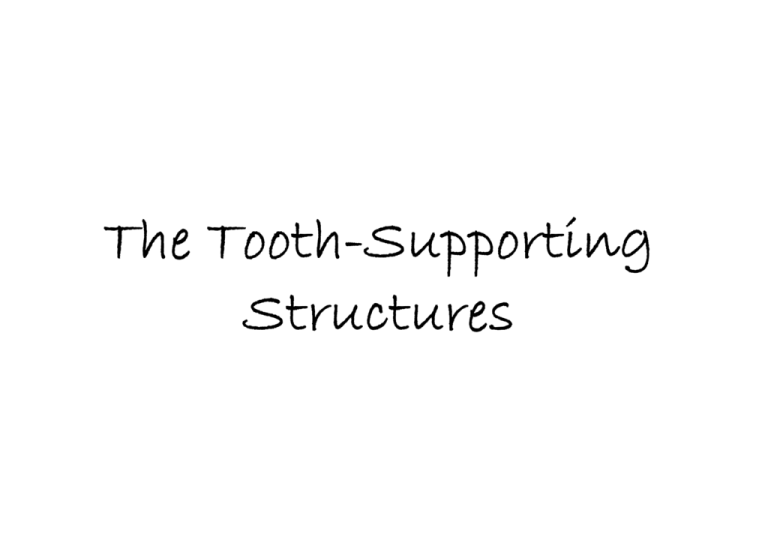
The Tooth-Supporting Structures • • • • • PERIODONTAL LIGAMENT CEMENTUM ALVEOLAR PROCESS DEVELOPMENT OF THE ATTACHMENT APPARATUS EXTERNAL FORCES AND THE PERIODONTIUM PERIODONTAL LIGAMENT • The periodontal ligament is the connective tissue that surrounds the root and connects it to the bone. • It is continuous with the connective tissue of the gingiva and communicates with the marrow spaces through vascular channels in the bone. Periodontal Fibers • The most important elements of the periodontal ligament are the principal fibers, which are collagenous, are arranged in bundles, and follow a wavy course when viewed in longitudinal sections . • Terminal portions of the principal fibers that insert into cementum and bone are termed Sharpey's fibers. • The principal fiber bundles consist of individual fibers that form a continuous anastomosing network between tooth and bone. • Collagen is a protein composed of different amino acids, the most important of which are glycine, proline, hydroxylysine, and hydroxyproline. • The amount of collagen in a tissue can be determined by its hydroxyproline content. • Collagen is synthesized by fibroblasts, osteoblasts, odontoblasts, and other cells. The several types of collagen are all distinguishable by their chemical composition, distribution, function, and morphology. • The principal fibers are composed mainly of collagen type I, whereas reticular fibers are composed of collagen type III. Collagen type IV is found in the basal lamina The principal fibers of the periodontal ligament are arranged in six groups that develop sequentially in the developing root: 1. the transseptal 2. alveolar crest 3. Horizontal 4. Oblique 5. Apical 6. and interradicular fibers • Transseptal group: Transseptal fibers extend interproximally over the alveolar bone crest and are embedded in the cementum of adjacent teeth. • These fibers may be considered as belonging to the gingiva because they do not have osseous attachment. • Alveolar crest group: Alveolar crest fibers extend obliquely from the cementum just beneath the junctional epithelium to the alveolar crest • Horizontal group: Horizontal fibers extend at right angles to the long axis of the tooth from the cementum to the alveolar bone. • Oblique group: Oblique fibers, the largest group in the periodontal ligament, extend from the cementum in a coronal direction obliquely to the bone. • Apical group: The apical fibers radiate in a rather irregular fashion from the cementum to the bone at the apical region of the socket. They do not occur on incompletely formed roots. • Interradicular fibers: The interradicular fibers fan out from the cementum to the tooth in the furcation areas of multirooted teeth. • Although the periodontal ligament does not contain mature elastin, two immature forms are found—oxytalan and eluanin. The so-called oxytalan fibers run parallel to the root surface in a vertical direction and bend to attach to cementum in the cervical third of the root. They are thought to regulate vascular flow. An elastic meshwork has been described in the periodontal ligament59 as being composed of many elastin lamellae with peripheral oxytalan fibers and eluanin fibers. Oxytalan fibers have been shown to develop de novo in the regenerated periodontal ligament. • The principal fibers are remodeled by the periodontal ligament cells to adapt to physiologic needs and in response to different stimuli. • In addition to these fiber types, small collagen fibers associated with the larger principal collagen fibers have been described. These fibers run in all directions, forming a plexus called the indifferent fiber plexus. Cellular Elements • Four types of cells have been identified in the periodontal ligament: 1. 2. 3. 4. Connective tissue cells, Epithelial rest cells, Immune system cells, cells associated with neurovascular elements. • Connective tissue cells include: 1. fibroblasts, 2. cementoblasts, 3. and osteoblasts. • Fibroblasts are the most common cells in the periodontal ligament and appear as ovoid or elongated cells oriented along the principal fibers. These cells synthesize collagen and also possess the capacity to phagocytose “old” collagen fibers and degrade them by enzyme hydrolysis. Thus collagen turnover appears to be regulated by fibroblasts in a process of intracellular degradation of collagen not involving the action of collagenase. Osteoblasts and cementoblasts, as well as osteoclasts and odontoclasts, also are seen in the cemental and osseous surfaces of the periodontal ligament. • • • • The epithelial rests of Malassez form a latticework in the periodontal ligament and appear as either isolated clusters of cells or interlacing strands • The epithelial rests are considered remnants of Hertwig's root sheath, which disintegrates during root development. • Epithelial rests are distributed close to the cementum throughout the periodontal ligament of most teeth and are most numerous in the apical and cervical areas • Epithelial rests proliferate when stimulated and participate in the formation of periapical cysts and lateral root cysts. Human periodontal ligament with rosette-shaped epithelial rests (arrows) lying close to the cementum (C). • The defense cells include neutrophils, lymphocytes, macrophages, mast cells, and eosinophils. These, as well as those cells associated with neurovascular elements, are similar to those in other connective tissues. Ground Substance • The periodontal ligament consists of two main components: glycosaminoglycans, such as hyaluronic acid and proteoglycans, and glycoproteins such as fibronectin and laminin. It also has a high water content (70%). • The periodontal ligament also may contain calcified masses called cementicles, which are adherent to or detached from the root surfaces Cementicles in the periodontal ligament, one lying free and the other adherent to the tooth surface. • Cementicles may develop from calcified epithelial rests; around small spicules of cementum or alveolar bone traumatically displaced into the periodontal ligament; from calcified Sharpey's fibers; and from calcified, thrombosed vessels within the periodontal ligament. Functions of the Periodontal Ligament The functions of the periodontal ligament are: 1. 2. 3. 4. Physical. Formative and remodeling. Nutritional. and Sensory. • Physical Function. The physical functions of the periodontal ligament entail the following: 1. Provision of a soft tissue “casing” to protect the vessels and nerves from injury by mechanical forces 2. Transmission of occlusal forces to the bone 3. Attachment of the teeth to the bone 4. Maintenance of the gingival tissues in their proper relationship to the teeth 5. Resistance to the impact of occlusal forces (shock absorption) RESISTANCE TO THE IMPACT OF OCCLUSAL FORCES (SHOCK ABSORPTION) • Two theories relative to the mechanism of tooth support have been considered the Tensional and Viscoelastic System theories. • The tensional theory of tooth support ascribes to the principal fibers of the periodontal ligament the major responsibility in supporting the tooth and transmitting forces to the bone. • When a force is applied to the crown, the principal fibers first unfold and straighten and then transmit forces to the alveolar bone, causing an elastic deformation of the bony socket. • Finally, when the alveolar bone has reached its limit, the load is transmitted to the basal bone. • Many investigators find this theory insufficient to explain available experimental evidence. The viscoelastic system theory: • considers the displacement of the tooth to be largely controlled by fluid movements, with fibers having only a secondary role. • When forces are transmitted to the tooth, the extracellular fluid passes from the periodontal ligament into the marrow spaces of bone . TRANSMISSION OF OCCLUSAL FORCES TO THE BONE. • When an axial force is applied to a tooth, a tendency toward displacement of the root into the alveolus occurs. The oblique fibers alter their wavy, untensed pattern; assume their full length; and sustain the major part of the axial force. • When a horizontal or tipping force is applied, two phases of tooth movement occur. The first is within the confines of the periodontal ligament, and the second produces a displacement of the facial and lingual bony plates. The tooth rotates about an axis that may change as the force is increased. • The apical portion of the root moves in a direction opposite to the coronal portion. In areas of tension, the principal fiber bundles are taut rather than wavy. In areas of pressure, the fibers are compressed, the tooth is displaced, and a corresponding distortion of bone exists in the direction of root movement. • In single-rooted teeth, the axis of rotation is located in the area between the apical third and the middle third of the root • In multirooted teeth, the axis of rotation is located in the bone between the roots Formative and Remodeling Function • Cells of the periodontal ligament participate in the formation and resorption of cementum and bone, which occur in physiologic tooth movement; in the accommodation of the periodontium to occlusal forces; and in the repair of injuries. • Variations in cellular enzyme activity are correlated with the remodeling process. • Nutritional and Sensory Functions. The periodontal ligament supplies nutrients to the cementum, bone, and gingiva by way of the blood vessels and provides lymphatic drainage CEMENTUM • Cementum is the calcified tissue that forms the outer covering of the anatomic root. The two main types of cementum are acellular (primary) and cellular (secondary) cementum. • Both consist of a calcified interfibrillar matrix and collagen fibrils. • The two sources of collagen fibers in cementum are Sharpey's (extrinsic) fibers, and fibers that belong to the cementum matrix perse (intrinsic) produced by the cementoblasts. • Cementoblasts also form the noncollagenous components of the interfibrillar ground substance, such as proteoglycans, glycoproteins, and phosphoproteins. • Acellular cementum is the first to be formed and covers approximately the cervical third or half of the root; it does not contain cells. This cementum is formed before the tooth reaches the occlusal plane, and its thickness ranges from 30 to 230 µm. • Sharpey's fibers comprise most of the structure of acellular cementum, which has a principal role in supporting the tooth. • Acellular cementum also contains intrinsic collagen fibrils that are calcified and irregularly arranged or parallel to the surface. Acellular cementum (AC) showing incremental lines running parallel to the long axis of the tooth. • Cellular cementum, formed after the tooth reaches the occlusal plane, is more irregular and contains cells (cementocytes). • Cellular cementum is less calcified than the acellular type. • Sharpey's fibers occupy a smaller portion of cellular cementum and are separated by other fibers that are arranged either parallel to the root surface or at random. Cellular cementum (CC) showing cementocytes lying within lacunae. Cellular cementum is thicker than acellular cementum • Schroeder has classified cementum as follows: • Acellular afibrillar cementum (AAC) contains neither cells nor extrinsic or intrinsic collagen fibers, apart from a mineralized ground substance. It is a product of cementoblasts and is found as coronal cementum in humans, with a thickness of 1 to 15 µm. • Acellular extrinsic fiber cementum (AEFC) is composed almost entirely of densely packed bundles of Sharpey's fibers and lacks cells. It is a product of fibroblasts and cementoblasts and is found in the cervical third of roots in humans but may extend further apically. Its thickness is between 30 and 230 µm. • Cellular mixed stratified cementum (CMSC) is composed of extrinsic (Sharpey's) and intrinsic fibers and may contain cells. It is a co-product of fibroblasts and cementoblasts, and in humans it appears primarily in the apical third of the roots and apices and in furcation areas. Its thickness ranges from 100 to 1000 µm. • Cellular intrinsic fiber cementum (CIFC) contains cells but no extrinsic collagen fibers. It is formed by cementoblasts, and in humans it fills resorption lacunae. • Intermediate cementum is an ill-defined zone near the cementodentinal junction of certain teeth that appears to contain cellular remnants of Hertwig's sheath embedded in calcified ground substance. • The inorganic content of cementum (hydroxyapatite; Ca10[Po4]6[OH]2) is 45% to 50%, which is less than that of bone (65%), enamel (97%), or dentin (70%). • No relationship has been established between aging and the mineral content of cementum. Cementoenamel Junction • Three types of relationships involving the cementum may exist at the cementoenamel junction. 1.60% to 65% of cases, cementum overlaps the enamel 2.30% an edge-to-edge butt joint exists. 3.5% to 10% the cementum and enamel fail to meet. Thickness of Cementum • Cementum deposition is a continuous process that proceeds at varying rates throughout life. • It attains its greatest thickness (up to 150 to 200 µm) in the apical third and in the furcation areas. • It is thicker in distal surfaces than in mesial surfaces, probably because of functional stimulation from mesial drift over time. • The age play role in the thickness of cementum • The term hypercementosis (cementum hyperplasia) refers to a prominent thickening of the cementum. It may be localized to one tooth or affect the entire dentition. Because of considerable physiologic variation in the thickness of cementum among different teeth in the same person and also among different persons, distinguishing between hypercementosis and physiologic thickening of cementum is sometimes difficult. Cementum Resorption and Repair • Cementum resorption may be caused by local or systemic causes or may occur without apparent etiology (i.e., idiopathic). • Among the local conditions in which it occurs are trauma from occlusion; orthodontic movement; pressure from malaligned erupting teeth, cysts, and tumors; teeth without functional antagonists; embedded teeth; replanted and transplanted teeth; periapical disease; and periodontal disease. • Among the systemic conditions mentioned as predisposing to or inducing cemental resorption are calcium deficiency, hypothyroidism, hereditary fibrous osteodystrophy, and Paget's disease. Section showing repair of previously resorbed root. The defect is filled in with cellular cementum (C), which is separated from the older cementum (R) by an irregular line (L) t • Ankylosis. occurs in teeth with cemental resorption, which suggests that it may represent a form of abnormal repair. Ankylosis also may develop after chronic periapical inflammation, tooth replantation, and occlusal trauma and around embedded teeth. Exposure of Cementum to the Oral Environment • Cementum becomes exposed to the oral environment in cases of gingival recession and as a consequence of loss of attachment in pocket formation. The cementum is sufficiently permeable to be penetrated in these cases by organic substances, inorganic ions, and bacteria. Bacterial invasion of the cementum occurs commonly in periodontal disease. Caries of the cementum also can develop. ALVEOLAR PROCESS • The alveolar process is the portion of the maxilla and mandible that forms and supports the tooth sockets (alveoli). It forms when the tooth erupts to provide the osseous attachment to the forming periodontal ligament; it disappears gradually after the tooth is lost. • The alveolar process consists of the following: 1. An external plate of cortical bone formed by haversian bone and compacted bone lamellae 2. The inner socket wall of thin, compact bone called the alveolar bone proper, which is seen as the lamina dura in radiographs. Histologically, it contains a series of openings (cribriform plate) through which neurovascular bundles link the periodontal ligament with the central component of the alveolar bone, the cancellous bone. 3 Cancellous trabeculae, between these two compact layers, which act as supporting alveolar bone. The interdental septum consists of cancellous supporting bone enclosed within a compact border . in addition, the jaw bones consist of the basal bone, which is the portion of the jaw located apically but unrelated to the teeth Mesiodistal section through mandibular canine and premolars showing interdental bony septa. The dense bony plates (A) cancellous bony trabeculae (C) Cells and Intercellular Matrix • Osteoblasts, the cells that produce the organic matrix of bone, are differentiated from pluripotent follicle cells. • Alveolar bone is formed during fetal growth by intramembranous ossification and consists of a calcified matrix with osteocytes enclosed within spaces called lacunae. The osteocytes extend processes into canaliculi that radiate from the lacunae. The canaliculi form an anastomosing system through the intercellular matrix of the bone, which brings oxygen and nutrients to the osteocytes through the blood and removes metabolic waste products. Blood vessels branch extensively and travel through the periosteum. The endosteum lies adjacent to the marrow vasculature. Bone growth occurs by apposition of an organic matrix that is deposited by osteoblasts. Haversian systems (osteons) are the internal mechanisms that bring a vascular supply to bones too thick to be supplied only by surface vessels. These are found primarily in the outer cortical plates and the alveolar bone proper. • Bone consists of two-thirds inorganic matter and one-third organic matrix. • The inorganic matter is composed principally of the minerals calcium and phosphate, along with hydroxyl, carbonate, citrate, and trace amounts of other ions such as sodium, magnesium, and fluorine. The mineral salts are in the form of hydroxyapatite crystals of ultramicroscopic size and constitute approximately two thirds of the bone structure. • The organic matrix consists mainly (90%) of collagen type I, with small amounts of noncollagenous proteins such as osteocalcin, osteonectin, bone morphogenetic protein, phosphoproteins, and proteoglycans. • Remodeling is the major pathway of bony changes in shape, resistance to forces, repair of wounds, and calcium and phosphate homeostasis in the body. • Bone resorption is a complex process morphologically related to the appearance of eroded bone surfaces (Howship's lacunae) and large, multinucleated cells (osteoclasts) • The activity of osteoclasts and morphology of the ruffled border can be modified and regulated by hormones such as parathormone (indirectly) and calcitonin, which has receptors on the osteoclast membrane. • Ten Cate described the sequence of events in the resorptive process as follows: 1. Attachment of osteoclasts to the mineralized surface of bone 2. Creation of a sealed acidic environment through action of the proton pump, which demineralizes bone and exposes the organic matrix 3. Degradation of the exposed organic matrix to its constituent amino acids by the action of released enzymes, such as acid phosphatase and cathepsine 4. Sequestering of mineral ions and aminoacids within the osteoclast Socket Wall • The socket wall consists of dense, lamellated bone, some of which is arranged in haversian systems, and bundle bone. Bundle bone is the term given to bone adjacent to the periodontal ligament that contains a great number of Sharpey's fibers • Bundle bone is not unique to the jaws; it occurs throughout the skeletal system wherever ligaments and muscles are attached. • • • • The darkly stained bone (B1) is lamellar bone. Bundle bone (B2) takes up less stain and shows numerous white lines running more or less parallel to each other; these lines correspond to Sharpey's fibers. M, Fatty marrow; PL, periodontal ligament. • The cancellous portion of the alveolar bone consists of trabeculae that enclose irregularly shaped marrow spaces lined with a layer of thin, flattened endosteal cells • Cancellous bone is found predominantly in the interradicular and interdental spaces and in limited amounts facially or lingually, except in the palate. In the adult human, more cancellous bone exists in the maxilla than in the mandible. Periosteum and Endosteum • The tissue covering the outer surface of bone is termed periosteum, whereas the tissue lining the internal bone cavities is called endosteum. • The periosteum consists of an inner layer composed of osteoblasts surrounded by osteoprogenitor cells, which have the potential to differentiate into osteoblasts, and an outer layer rich in blood vessels and nerves and composed of collagen fibers and fibroblasts • Bundles of periosteal collagen fibers penetrate the bone, binding the periosteum to the bone. The endosteum is composed of a single layer of osteoblasts and sometimes a small amount of connective tissue. Osseous Topography • The bone contour normally conforms to the prominence of the roots, with intervening vertical depressions that taper toward the margin • The height and thickness of the facial and lingual bony plates are affected by the alignment of the teeth, angulation of the root to the bone, and occlusal forces. Fenestrations and Dehiscences • Isolated areas in which the root is denuded of bone and the root surface is covered only by periosteum and overlying gingiva are termed fenestrations. In these instances the marginal bone is intact. When the denuded areas extend through the marginal bone, the defect is called a dehiscence. Dehiscence on the canine and fenestration of the first premolar Remodeling of Alveolar Bone • The remodeling of the alveolar bone affects its height, contour, and density, and it is manifested in the following three areas: • adjacent to the periodontal ligament, in relation to the periosteum of the facial and lingual plates • and along the endosteal surface of the marrow spaces. DEVELOPMENT OF THE ATTACHMENT APPARATUS • After the crown has formed, the stratum intermedium and the stellate reticulum of the enamel organ disappear. The outer and inner epithelia of the enamel organ remain and form the so-called reduced enamel epithelium. The apical portion of this constitutes Hertwig's epithelial root sheath, which will continue to grow apically and determines the shape of the root. Before the beginning of root formation, the root sheath bends horizontally at the future cementoenamel junction, narrowing the cervical opening and forming the epithelial diaphragm. The epithelial diaphragm separates the dental follicle from the dental papilla. • After root dentin formation starts, Hertwig's root sheath breaks up and partially disappears; the remaining cells form the epithelial clusters or strands known as epithelial rests of Malassez Human periodontal ligament with rosette-shaped epithelial rests (arrows) lying close to the cementum (C). EXTERNAL FORCES AND THE PERIODONTIUM • The periodontium exists for the purpose of supporting teeth during function and depends on the stimulation it receives from function for the preservation of its structure. Therefore a constant and sensitive balance is present between external forces and the periodontal structures. • Alveolar bone undergoes constant physiologic remodeling in response to external forces, particularly occlusal forces. Bone is removed from areas where it is no longer needed and added to areas where it is presently needed. • The periodontal ligament also depends on stimulation provided by function to preserve its structure. Within physiologic limits, the periodontal ligament can accommodate increased function with an increase in width , a thickening of its fiber bundles, and an increase in diameter and number of Sharpey's fibers. • When occlusal forces are reduced, the number and thickness of the trabeculae are reduced. The periodontal ligament also atrophies, appearing thinned, and the fibers are reduced in number and density, disoriented, and ultimately arranged parallel to the root surface. • This is termed disuse or afunctional atrophy. In this condition, the cementum is either unaffected or thickened and the distance from the cementoenamel junction to the alveolar crest is increased. Any Questions?
